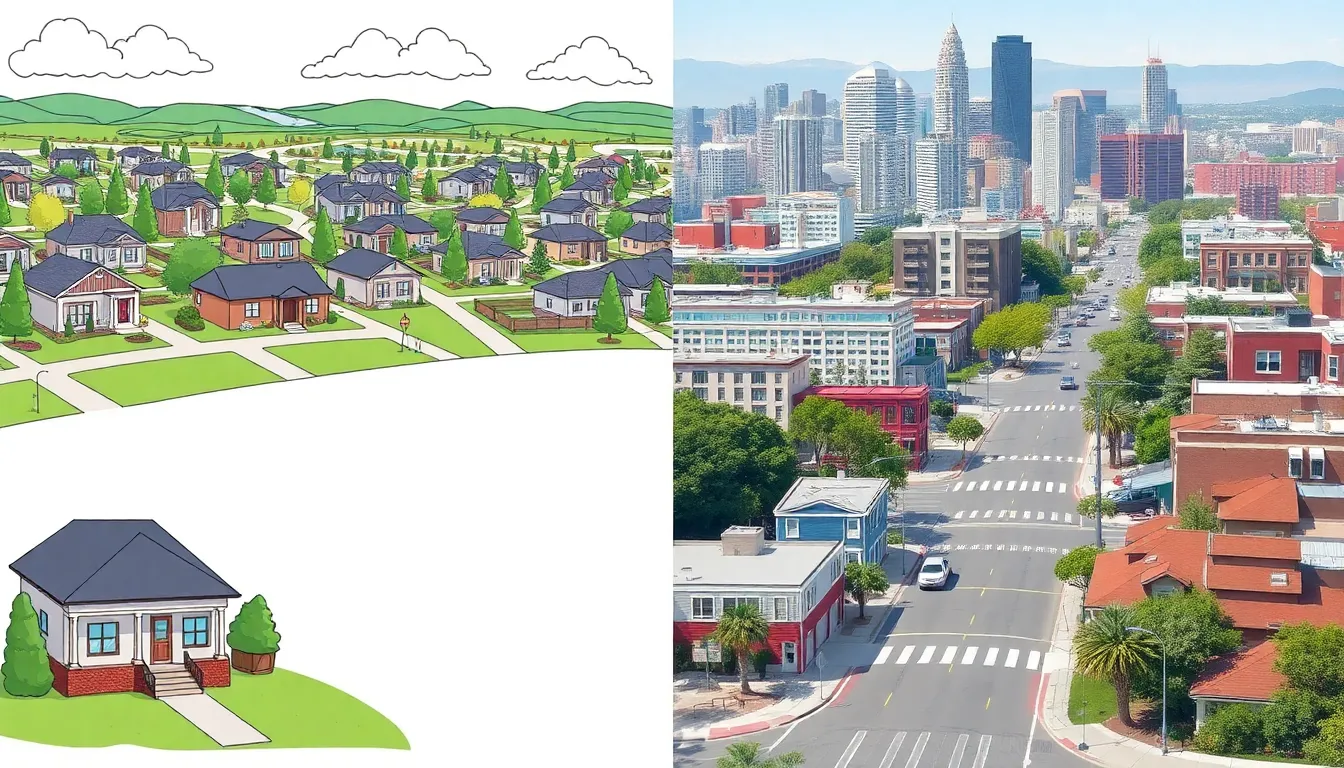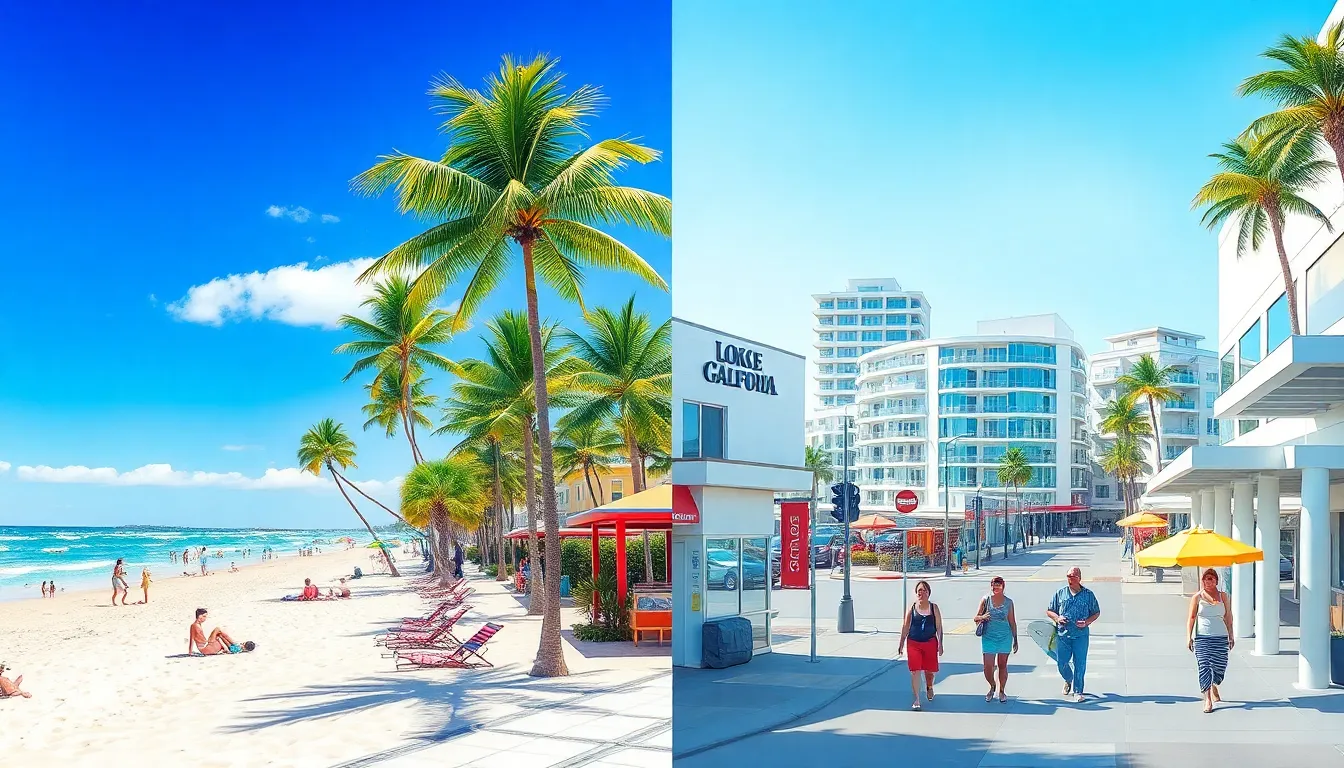When it comes to choosing where to plant roots, the cost of living can feel like a game of Monopoly—only with real money and no “Get Out of Jail Free” cards. On one side, there’s California, the land of sunshine, surfboards, and a price tag that might make you consider living in a van down by the river. On the other, Idaho offers stunning landscapes and a cost of living that won’t have you selling your kidneys for rent.
In this showdown, we’ll dive into the nitty-gritty of what it really costs to live in these two states. From housing prices to grocery bills, understanding the financial landscape can help anyone make a savvy move. So whether you’re dreaming of a cozy cabin in Idaho or a beachside bungalow in California, let’s break down the numbers and find out which state truly delivers the best bang for your buck.
Table of Contents
ToggleOverview of Cost of Living
Housing costs differ significantly between Idaho and California. Idaho’s average home price stands around $332,000, whereas California’s average home price often exceeds $800,000. Rent also illustrates this disparity; a one-bedroom apartment averages $1,200 in Idaho, while the same apartment can reach $2,500 or more in California’s urban centers.
Transportation expenses vary as well. Residents in Idaho spend about $1,000 annually on transportation, which includes gas and public transit. In contrast, Californians face higher transportation costs, approximately $1,300 per year, due to longer commutes and congestion.
Grocery prices reflect another difference. A typical family’s grocery bill in Idaho averages $600 monthly, covering essentials like fruits, vegetables, and dairy. California families often pay around $800 for the same items, influenced by factors like local taxes and market demand.
Healthcare expenses also provide a noticeable contrast. Idaho residents usually pay about $4,500 yearly for healthcare services. California residents often experience costs upwards of $5,800 annually, due to higher premiums and service fees.
Lifestyle factors impact overall cost of living as well. Outdoor activities, dining, and entertainment options differ in accessibility and expense. Idaho offers numerous free or low-cost outdoor activities, while California’s entertainment and dining experiences frequently come with premium price tags.
Idaho presents more affordability in housing, transportation, groceries, and healthcare compared to California. Understanding these cost factors aids in making informed decisions about relocation and lifestyle preferences.
Housing Costs

Housing costs display stark contrasts between Idaho and California. The average home price in Idaho stands at about $332,000, making homeownership significantly more attainable than in California, where prices exceed $800,000.
Comparing Rent Prices
Rent prices illustrate a similar disparity. In Idaho, securing a one-bedroom apartment typically costs around $1,200. Urban California, on the other hand, sees rental prices reaching $2,500 or more. This difference highlights the affordability of rentals in Idaho, making it an attractive option for those looking to minimize living expenses.
Home Purchase Costs
Home purchase costs reveal a significant gap situated between both states. Idaho’s average home price of $332,000 offers buyers a chance at lower mortgage payments and potentially less financial strain. California’s steep average price of over $800,000 requires larger down payments and higher monthly mortgage obligations, pushing many prospective homeowners to seek more affordable options elsewhere.
Utilities and Other Expenses
Utilities and other expenses significantly impact overall living costs in Idaho and California. Understanding the differences provides insight into budgeting for daily life.
Electricity and Water
Electricity costs in Idaho average around $110 monthly, while Californians pay approximately $140. Water bills also reflect this disparity; Idaho residents spend about $40, contrasting with California’s $60. Factors contributing to these differences include climate and infrastructure. Idaho’s milder weather reduces electricity usage compared to California’s heat. Conservation practices are more prevalent in Idaho, further helping residents manage their bills efficiently.
Internet and Phone Service
Monthly internet services in Idaho average about $60, whereas California residents pay nearly $80 for similar packages. This difference arises from the higher demand for faster service in metropolitan California. Additionally, phone service costs range around $60 in Idaho compared to $70 in California. Providers in Idaho often deliver competitive rates due to lower operational costs, making it easier for residents to stay connected without overspending. Adopting the right plan can yield significant savings in both states.
Transportation Costs
Transportation costs vary significantly between Idaho and California. Idaho generally offers lower expenses, providing residents with a more affordable option for commuting.
Gas Prices
Gas prices in Idaho average about $3.50 per gallon. Comparatively, California sees higher prices, often exceeding $5 per gallon. This difference leads to significant savings for Idaho drivers, particularly with frequent travel. Lower prices contribute to reduced overall transportation budgets, benefiting families and individuals alike. Additionally, Idaho’s more rural setting often results in shorter commutes, further lowering gas-related expenses.
Public Transportation Options
Public transportation options in Idaho are less extensive than in California. In cities like Boise, services primarily focus on buses, with limited routes. California offers a wider array of public transit options including buses, subways, and light rail systems in metropolitan areas. Many Californians rely on these services for daily commutes, impacting their overall transportation expenses. However, Idaho’s lower population density may result in less demand, influencing the availability of transit options. Ultimately, those considering a move must weigh these factors when evaluating transportation costs in each state.
Groceries and Dining
Grocery and dining expenses differ significantly between Idaho and California. While Idaho offers affordability, California’s costs soar.
Grocery Prices and Trends
Grocery prices stand out in this comparison. Idaho families spend around $600 monthly on groceries, while California families spend about $800. Staples like milk average $2.50 per gallon in Idaho compared to $4 in California. Fresh produce prices in Idaho often reflect lower costs, with a head of lettuce costing $1 versus $2 in California. Idaho’s shopping options contribute to these savings, with many local markets offering competitive pricing. Additionally, bulk buying works well in Idaho, providing families with further savings. These trends highlight how grocery expenses significantly impact overall living costs in both states.
Restaurant Costs
Restaurant costs reveal another layer in this comparison. Dining out in Idaho typically costs less, with an average meal for one at $15, against California’s $20 average. Mid-range restaurants in Idaho charge around $50 for a meal for two, while California establishments often reach $75. Fast food options follow similar patterns, as meals in Idaho cost about $8, compared to $10 in California. Availability of local eateries in Idaho enhances dining experiences without high price tags. These restaurant costs underscore the financial benefits of living in Idaho versus California.
Quality of Life
Idaho and California present distinct quality of life experiences. Each state offers unique advantages in education, healthcare, and work-life balance.
Education and Healthcare
Education systems differ significantly between Idaho and California. Idaho’s schools often receive high marks for quality, emphasizing personalized attention due to smaller class sizes. Healthcare costs illustrate another disparity; Idaho residents pay around $4,500 annually, while Californians incur much higher costs, averaging over $5,800. Access to healthcare services varies, with urban areas in California providing a broader array of specialists. Idaho’s rural settings may limit immediate access but often feature friendly, community-focused healthcare. Families seeking quality education and affordable healthcare find Idaho appealing, particularly when comparing expenses and availability.
Work-Life Balance
Work-life balance trends vary in both states. Idaho attracts individuals with its more relaxed pace of life, allowing for ample outdoor activities. Fewer commuters enjoy shorter travel times, with average transportation costs at about $1,000 per year. In California’s urban centers, long commutes can detract from personal time. Despite its high earnings potential, the fast-paced environment often leads to stress. Residents in Idaho frequently report higher satisfaction levels due to a less hectic lifestyle and better access to nature. This balance plays a critical role in quality of life assessments when comparing Idaho and California.
Choosing between Idaho and California involves weighing financial realities against lifestyle preferences. Idaho offers a significantly lower cost of living with affordable housing and essential expenses. This makes it an attractive option for those seeking financial stability and a more relaxed lifestyle.
On the other hand, California presents a vibrant environment with diverse opportunities but comes at a steep price. The decision ultimately hinges on individual priorities such as career aspirations, family considerations, and personal values. Whether one leans toward Idaho’s affordability or California’s allure, understanding these factors is crucial for making the best choice.






